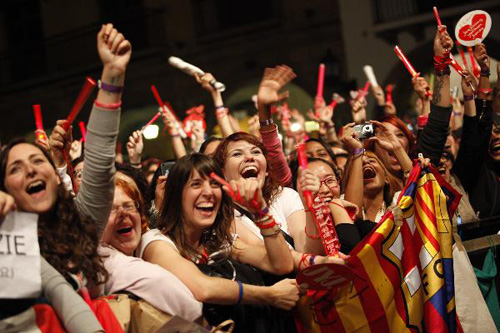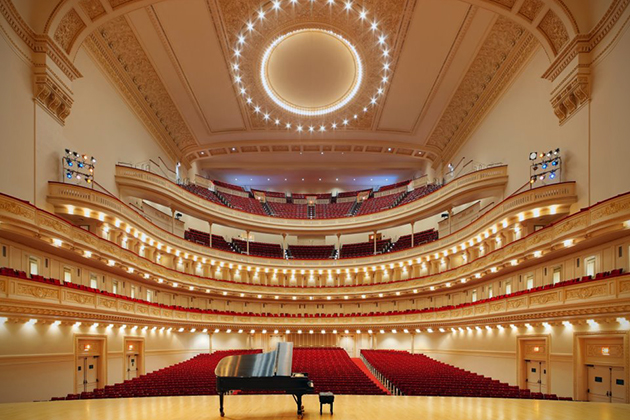Music as a Function in Society
Music’s function within society is highly dependent on the environment in which it is performed. While music composed by the child-prodigy Wolfgang Mozart is now primarily listened to in formal settings with the audience's undivided attention, during his lifetime, the audience was usually preoccupied with other activities. In his book Mozart, Peter Gay explains that during Mozart’s childhood, his family would perform at parties while audience members would listen “at best intermittent[ly],” (14). Gay goes on further explaining, “In Mozart’s day, music, sacred music alone excepted, was still largely mere entertainment,” (14). In Salzburg, during Mozart's life, music acted more as background music than anything else. Music’s function within that society has now evolved into being used as main entertainment in formal settings in addition to how it was used previously. In concert halls and a few restaurants, such as Dimitriou’s Jazz Alley, music is the primary focus of entertainment. During street performances, parades, and in most restaurants, however, music is not the primary focus of the event, similar to during Mozart’s early career.





When considering the traditions through which people consume music, large-scale concert going is one of the most popular approaches to enjoying live performance. Attending a live concert is a unique and intimate experience. It allows the listener to develop a strong, in-person relationship with the musician(s). Two popular venues for hosting large-scale concerts include concert halls and stadiums. Christopher Small, author of Musicking explains, “The scale of any building, and the attention that is paid to its design and appearance, tells us much about the social importance and status that is accorded to what goes on within it” (20). Some concert venues, such as stadiums, often “leave room for a variety of activities and relationships” (20), whereas concert halls impose a firm structure thus implying the type of experience meant to go on within them.
Due to the informal nature of the average pop/rock/country concert, audience members often leave their assigned seats to be as close to the stage as possible. These concerts are much more participatory than classical concerts. Concert-goers often jump up and cheer, dance, and even scream the lyrics with the performer. This sort of music is not intended to merely be listened to, rather it is designed to give the audience an experience of being close with the performer.
By contrast, formal concert halls enforce a sort of unspoken etiquette which all audience members are expected to follow. Professional classical musicians are seen as higher members of society, as their craft requires several years of intense training and dedication. In turn, classical performers demand a higher level of respect from the audience. The listeners are expected to remain silent in their assigned seats, enjoy the music, then applaud when the performance is over. The concert hall itself is designed to promote an individual experience for each audience member. The seats are placed in rows facing the stage, which discourages audience interaction and encourages listeners to pay full attention to the performance.
Dutch sociologist Harry Ganzeboom theorized, “If people want to draw satisfaction from art consumption, their information processing capacity needs to be associated with the amount of cultural complexity of the target cultural forms” (Roose and Stichele 187). This theory assumes that audience members with a higher level of education are far more likely to consume high-brow music, whereas low-brow or popular music is more likely to be consumed by individuals with little or no education.
Street music is used as informal entertainment for those walking by. One of the most intriguing things about street music is there are no limits to what you can use to create music. Guitars, recorders, pots, pans, bottles, or anything that can create sound is fair game for a street performance. In this video, the performer uses buckets and drumsticks to create his own functional drum set.
As you may have noticed in the video, there are many people walking by as the performance is taking place. Many people talk over the music, enjoying it as a type of background music. Some people stop for a couple minutes to appreciate the artist’s talent and even drop a dollar or two to thank them for playing.
Parades are a special type of street music where crowds of people squeeze together to see a spectacle roll down the street. Roads are closed, and parade pathways are roped off. Here, music is enjoyed by an audience anxious to have a good time. Arguably the most famous parade in the United States is the annual Macy’s Thanksgiving Day Parade. This star-studded event in downtown New York is an intricately planned street performance. According to Trip Savvy, a visitor’s guide to New York, more than 3.5 million people line the parade route in New York City. The event is broadcasted on televisions nationwide, making it a Thanksgiving tradition for many households. Below is a video of Miley Cyrus performing on a float in the parade.
This parade in particular is special because of the way it incorporates both Hollywood and Broadway performances. By creating a stage on the street, broadway performers can interact with the crowd in a new and exciting way. The performance below, from the Tony award winning show, “Pippin”, demonstrates this.
Along with Concert Halls, Stadiums, Street Performances, and Parades, Restaurants and Bars have their own distinct ways in which they use music. Restaurants use music to provide a soothing atmosphere. Typically classical repertoire and jazz standards are heard in the background. While the majority of restaurants use these styles of music as background accompaniment to highlight dinner as the main attraction, some venues, such as Dimitriou's Jazz Alley in Seattle, actually highlight music as the main attraction.
While music is used to create a calming experience in this restaurant, bars use music to make customers feel a completely different way. Bar music tends to lean toward genres such as Folk or Rock n’ Roll because they are capable of producing a loud and raunchy atmosphere. Music in a bar setting is not the primary source of entertainment, but it does provoke the people within the bar to drink. Professor Nicolas Guéguen at the Université de Bretagne-Sud in France conducted a study about the effects of loud music on individuals in the bar setting. “They found that with the music up high, the men drank on average 3.4 beers and took 11.5 minutes to knock each back. At the more mellow volume level, the men ordered 2.6 drinks on average and supped for a more leisurely 14.5 minutes” (Randerson). Along with producing a more alcohol friendly environment, bar music serves as a platform for people to sing Karaoke. As illustrated in the video below, individuals are able to sing along with famous songs and entertain other people in the bar.
Restaurant and bar owners purposely use these different genres of music to influence the customer's feelings in their atmospheres.
Music is a versatile art form that has many functions within society. It can act as either the main source of entertainment (like during concerts), as background music (like it was used in Mozart's lifetime), or even a combination of the two.
Intro/Conclusion/Bibliography: Emilia Soot
Concert Halls/Stadiums: Anika Hille
Street Music/Parades/Blog: Mackenzie Taylor
Restaurant/Bar: Frank Saxton
Bibligoraphy:
Randerson, James. “Pump up the volume: pubs profit from louder music.” The Guardian, 18 July 2008, www.theguardian.com/science/2008/jul/19/medicalresearch.fooddrinks.
“Miley Cyrus at the Macys Thanksgiving Day Parade.” YouTube, 27 Aug. 2009, www.youtube.com/watch?v=0sXJgbsyH54.
“Best Drummer Ever [HD].” YouTube, 2 Oct. 2013, www.youtube.com/watch?v=FqJdzYY_Fas.
Roose, Henk, and Alexander Vander Stichele. “Living Room vs. Concert Hall: Patterns of Music Consumption in Flanders.” Social Forces, vol. 89, no. 1, 2010, pp. 185–207. JSTOR, JSTOR, www.jstor.org/stable/40927559.
Small, Christopher. “Musicking: the Meanings of Performing and Listening.” Musicking: the Meanings of Performing and Listening, Wesleyan Univ. Press, 2010, p. 20.
“PIPPIN (Broadway) - Medley [LIVE @ Macy's Thanksgiving Day Parade 2012.” YouTube, 30 Nov. 2015, www.youtube.com/watch?v=fYC2_zsO2zs.
Cross, Heather . “Tips for Seeing the Thanksgiving Day Parade in New York City.” Trip Savvy, 16 Oct. 2017, www.tripsavvy.com/nyc-thanksgiving-day-parade-tips-1613650.
Pictures:
Comments
Post a Comment